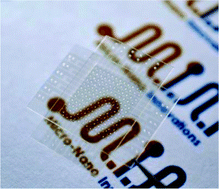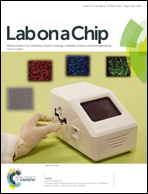Iontronic microdroplet array for flexible ultrasensitive tactile sensing†
Abstract
An iontronic microdroplet array (IMA) device, using an ultra-large interfacial capacitance at the highly elastic droplet–electrode contact, has been proposed for flexible tactile sensing applications. The transparent IMA sensors consist of an array of nanoliter droplets sandwiched between two polymeric membranes with patterned transparent electrodes, forming the electrical double layers with remarkable unit-area capacitance. Under external loading, the membrane deformation results in the circumferential expansion at the highly elastic droplet–electrode contact, which offers a completely new capacitive sensing scheme with a dramatic increase in sensitivity. Under the simple device architecture, the IMA has achieved device sensitivity of 0.43 nF kPa−1 and a minimal detectable pressure of 33 Pa, the highest reported values for its dimension. In addition, the hysteresis of the droplet deformation has been reduced by introducing a layer of hydrophobic coating to the conductive electrode surface, ensuring a fast mechanical response (on the order of several milliseconds). To demonstrate the utility of the transparent flexible IMA sensor, it has been successfully mounted onto a fingertip setting to map different surface topologies and embedded into a wristband to resolve dynamic pressure waves throughout cardiovascular cycles.


 Please wait while we load your content...
Please wait while we load your content...